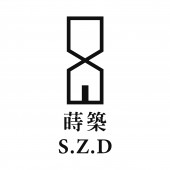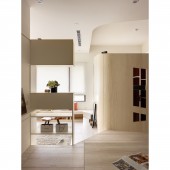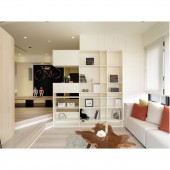DESIGN NAME:
Exclamation Mark
PRIMARY FUNCTION:
Residential House
INSPIRATION:
In the crowded urban area of Taipei, how we meet the practical need of a home in the limited space and keep the visual broadness and smooth? In the space of the 3.6-meter height, we transform area into volume in the vertically upward design and divide and re-organize the original space. The rise-and-fall stair extension and the diagonal line lead to different life fields, and also to create the leisurely and relaxing atmosphere.
UNIQUE PROPERTIES / PROJECT DESCRIPTION:
In the project, the four family members expect to live in a space full of boldness and creativity. After the communication with the designer, the original standard four-room layout is changed into the smooth life flow. Follow the arc line, make a turn, and get to the different fields. The owner hopes to have the sufficient storage function for his own collection and the bicycle. At the same time, he also needs the open space for the visit of the relatives and friends.
OPERATION / FLOW / INTERACTION:
The overall visual effect focuses on the wood pattern of white and light colors. At the center of the field is the large wooden mass with one side as the TV wall facing the living room and the other side used for the book wall and storage. Above is the study room. The side of the mass is wrapped with the arc and accompanied by the hollowed-out exclamation mark style in response to the refreshing and neat space characteristic. After the kitchen partition is removed, the broad large space is formed to meet the daily need of receiving family and friends. The bar turns and connects to the dining room. The dining table which can be automatically elevated and lowered is divided into three areas to flexibly arrange the table setting according to the number of guests. The elevated wooden floor functions as the dining chairs. When the door panel of the chair is opened, the interior can be used for storage.
PROJECT DURATION AND LOCATION:
The project started in Sep. 2017 and finished in Mar. 2018 in Taipei.
FITS BEST INTO CATEGORY:
Interior Space and Exhibition Design
|
PRODUCTION / REALIZATION TECHNOLOGY:
As the entrance leads to the indoor space, the stairs connect the field. The wall is equipped with the storage and display functions. At the center of the field is the large wooden mass with one side as the TV wall. The vertical space design is also used in the master bedroom, children room. After the kitchen partition is removed, the bar turns and connects to the dining room which can be automatically elevated and lowered is divided into three areas flexibly.
SPECIFICATIONS / TECHNICAL PROPERTIES:
The overall space focuses on the wood pattern of white and light colors. The diagonal lines connect the space to reduce the sharp feeling. The TV wall made of dyed white oak is a great visual point. The upper part of the façade is the diagonal line with the side wrapped with the arc and accompanied by the hollowed out exclamation mark style in response to the refreshing and neat space characteristic. The couch area of the living room extends to the staircase to the study room. The other side leads to the dining area. The staircase is equipped with the lighting function for both atmosphere and safety.
TAGS:
Interior, Design, House, Residence,
RESEARCH ABSTRACT:
On the basis of the nimble and flexible layout, flow, and casual storage, we make use of the vertical height to create the field functions. Through the connection of the staircase and the diagonal surface to the overall space, we create the high and low visual layers and reinforce the storage and exhibition space so that the collection can be stored and displayed. The open display rack design meets the practical and aesthetic needs.
CHALLENGE:
In the limited space, through the inspiration of high and low layers in the space, we create the special space meeting the owner’s expectation to include all life fields and fully store the owner’s interests.
ADDED DATE:
2018-07-03 07:21:59
TEAM MEMBERS (1) :
Designer:Chu Huang Shi
IMAGE CREDITS:
Haungshi Chu, 2018.
|










